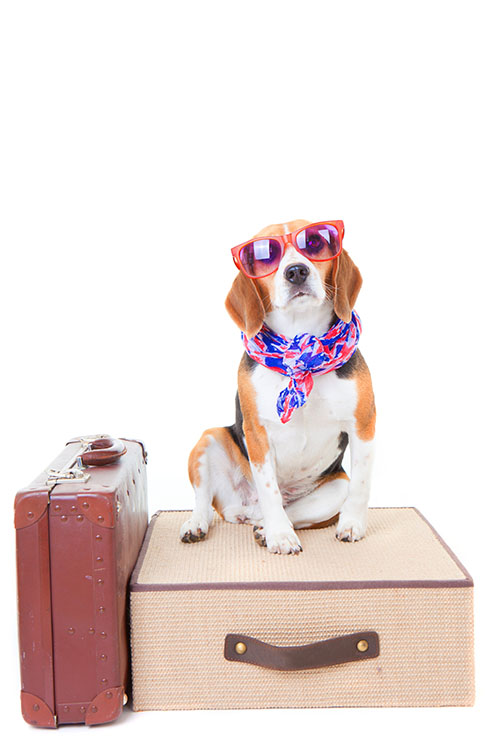We all love to travel but many pet lovers hate to leave their beloved pets behind. When it comes to long distance travel, preparation is the key writes Dr Jo Righetti.
Can your pet travel by air?
If you are planning a long-distance journey by air and would like your pet to accompany you, then you need to check that your pet are eligible for travel. Pets must be fit and healthy and able to cope with being confined for an extended period.
Your pet will not be accepted for travel if they are unwell, injured, heavily pregnant, recently given birth or less than 8 weeks old. If your pet is between 8 and 12 weeks or over 12 years old, your pet may need a health certificate to travel. Pets should not be sedated for the journey, as handlers need to ensure that they remain healthy during the entire journey.
Restricted breeds cannot fly and brachycephalic breeds (those with squashed muzzles) are more likely to suffer from respiratory distress and heat stress, placing them at risk during air travel. You must check with your vet prior to booking air travel.
Pets may also be affected by extreme weather conditions, so be cautious flying them during summer months or in extreme cold climates. Busy periods, such as school holidays, may also be difficult, as only limited number of pets can travel on certain flights, so book well ahead and understand that your pet may not travel on the same flight as you.
How your pet travels
Australian airlines require pets to travel as cargo, in the hold of the aircraft. The exception to this are Service Dogs and Assistance Dogs, who can travel with their owners, provided the dogs are accredited and have been trained.
Both Qantas and Virgin Australia fly pets within Australia. Your pet is required to travel within an approved travel crate. This must be the correct size for your pet, enabling them to turn around, yet be securely restrained. Specialist pet travel companies can help you determine the correct size of crate and you can also hire one. Again, this is best done well in advance, especially during busy periods. Contact Jet Pets or Dogtainers for more information.
Always ensure that your pet’s crate is clearly labelled and make sure that they are happy within it.
Introducing your pet to a crate
Make you pet’s crate as pleasant as possible by introducing your pet to it in a gradual, positive way. Allow your pet to enter the crate on their own, enticing them with taste treats or a favourite toy. Place their bed or a blanket in there too. Each time they go into the crate, extend the time they spend there. Begin to close the door, taking care not to frighten your pet and, again, extend the time they spend in their crate.
Travelling overseas?
If you are planning to travel to another country with your pet, you must fulfil the requirements of the destination country. You may need to begin this process many months before you travel.
A similar situation applies to pets travelling into Australia. Australia has strict quarantine requirements and you will need to allow up to 6 months’ preparation time prior to your pet’s travel. There are some countries that do not allow direct entry of pets into Australia.
When your pet arrives in this country, unless travelling from New Zealand, they will have to enter quarantine for 10 days. The only quarantine station in Australia is in Melbourne and you will need to arrange transport for your pet to their final destination after this time.
Seek more help from an approved International Pet and Animal Transportation Association (IPATA) pet agent.
All too difficult?
If your pet is ineligible for airline travel or it all just seems too difficult, it may help to take a little extra time for your journey and travel, with your pet, by car. If your pet is unused to car travel, build up gradually and make each trip a positive one. Your pet should be secured within a crate or by harness and seat belt. Take regular breaks along the way.
If your pet gets carsick, try to build up the time in the car gradually, give them water but not too much food before the journey and a little ginger in their diet may help.
Make sure your travel destination is pet friendly and try to keep your pet within their normal feeding and exercise routines while away from home. Enjoy your travels!
DID YOU KNOW??
Frequent Flyer Pet Points
Did you know if your pet flies with you on a Virgin Australia, you might be eligible for 300 Velocity Frequent Flyer points…??
Velocity Frequent Flyer, the loyalty program of Virgin Australia has a frequent flyer program for pets. Velocity members can now earn 300 Points each time their dog or cat flies on Virgin Australia’s domestic network. Silver, Gold and Platinum members will also receive a special Points bonus.
ABOUT
Dr Jo is an animal behaviourist who helps people understand pets. Jo is a proud Ambassador of Assistance Dogs Australia and Animal Welfare League Australia. Jo enjoys chatting to people through her social media sites, website and blog www.petproblemsolved.com.au/blog.























Add Comment